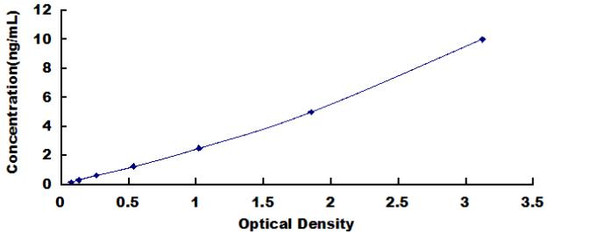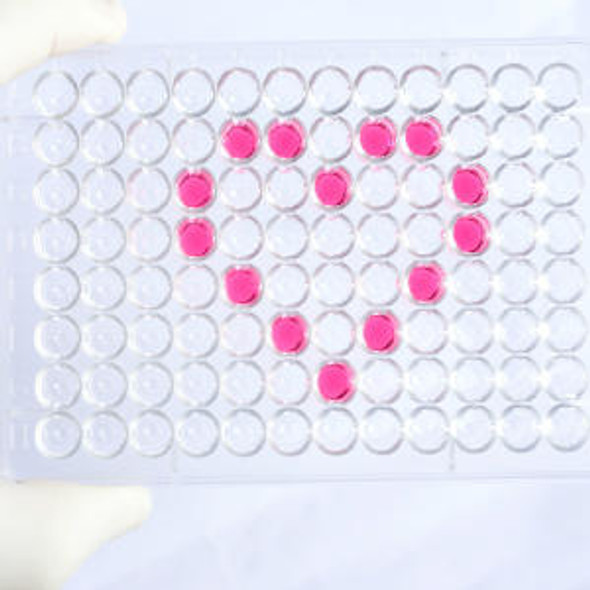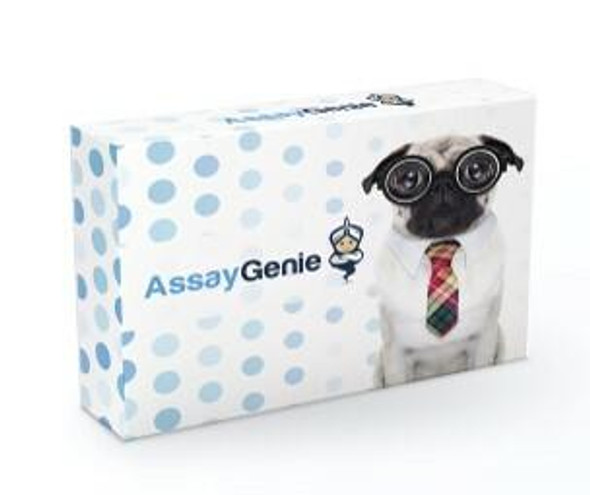Human Cell Biology ELISA Kits 5
Human Pax (Paxillin) CLIA Kit (HUES01216)
- SKU:
- HUES01216
- Product Type:
- ELISA Kit
- ELISA Type:
- CLIA Kit
- Size:
- 96 Assays
- Sensitivity:
- 18.75pg/mL
- Range:
- 31.25-2000pg/mL
- ELISA Type:
- Sandwich
- Reactivity:
- Human
- Sample Type:
- Serum, plasma and other biological fluids
- Research Area:
- Cell Biology
Description
| Assay type: | Sandwich |
| Format: | 96T |
| Assay time: | 4.5h |
| Reactivity: | Human |
| Detection method: | Chemiluminescence |
| Detection range: | 31.25-2000 pg/mL |
| Sensitivity: | 18.75 pg/mL |
| Sample volume: | 100µL |
| Sample type: | Serum, plasma and other biological fluids |
| Repeatability: | CV < 15% |
| Specificity: | This kit recognizes Human Pax in samples. No significant cross-reactivity or interference between Human Pax and analogues was observed. |
This kit uses Sandwich-CLIA as the method. The micro CLIA plate provided in this kit has been pre-coated with an antibody specific to Human Pax. Standards or samples are added to the appropriate micro CLIA plate wells and combined with the specific antibody. Then a biotinylated detection antibody specific for Human Pax and Avidin-Horseradish Peroxidase (HRP) conjugate are added to each micro plate well successively and incubated. Free components are washed away. The substrate solution is added to each well. Only those wells that contain Human Pax, biotinylated detection antibody and Avidin-HRP conjugate will appear fluorescence. The Relative light unit (RLU) value is measured spectrophotometrically by the Chemiluminescence immunoassay analyzer. The RLU value is positively associated with the concentration of Human Pax. The concentration of Human Pax in the samples can be calculated by comparing the RLU of the samples to the standard curve.
| UniProt Protein Function: | PXN: a multi-domain cytoskeletal protein involved in actin-membrane attachment that localizes primarily to focal adhesion sites to the extracellular matrix. Phosphorylated by focal adhesion kinase (FAK) and is a component of integrin signaling. Its phosphorylation provides docking sites for recruitment of signaling molecules to focal adhesions. Binds in vitro to vinculin as well as to the SH3 domain of c-SRC and, when tyrosine phosphorylated, to the Crk SH2 domain. Interacts with GIT1, NUDT16L1/SDOS, PARVA and TGFB1I1. Component of cytoplasmic complexes, which also contain GIT1, ARHGEF6 and PAK1. Binds DDEF2. Interacts with unphosphorylated ITGA4. Interacts with RNF5. Three alternatively-spliced isoforms have been described. Isoform beta binds to focal adhesion kinase but weakly to vinculin. Isoform gamma binds to vinculin but only weakly to focal adhesion kinase. |
| UniProt Protein Details: | Protein type:Adaptor/scaffold; Cytoskeletal; Motility/polarity/chemotaxis; Cell adhesion Chromosomal Location of Human Ortholog: 12q24. 31 Cellular Component: nucleoplasm; microtubule associated complex; focal adhesion; lamellipodium; cytoplasm; stress fiber; plasma membrane; cell cortex; cytosol Molecular Function:integrin binding; protein binding; zinc ion binding; beta-catenin binding; BH4 domain binding; protein kinase binding; vinculin binding Biological Process: integrin-mediated signaling pathway; lamellipodium biogenesis; epidermal growth factor receptor signaling pathway; focal adhesion formation; regulation of cell shape; peptidyl-tyrosine phosphorylation; branching morphogenesis of a tube; muscle contraction; activation of MAPK activity; transforming growth factor beta receptor signaling pathway; signal complex assembly; cytoskeleton organization and biogenesis; vascular endothelial growth factor receptor signaling pathway; signal transduction; cell adhesion |
| NCBI Summary: | This gene encodes a cytoskeletal protein involved in actin-membrane attachment at sites of cell adhesion to the extracellular matrix (focal adhesion). Alternatively spliced transcript variants encoding different isoforms have been described for this gene. These isoforms exhibit different expression pattern, and have different biochemical, as well as physiological properties (PMID:9054445). [provided by RefSeq, Aug 2011] |
| UniProt Code: | P49023 |
| NCBI GenInfo Identifier: | 317373486 |
| NCBI Gene ID: | 5829 |
| NCBI Accession: | P49023. 3 |
| UniProt Secondary Accession: | P49023,O14970, O14971, O60360, Q5HYA4, B2RAI3, B7ZMB4 |
| UniProt Related Accession: | P49023 |
| Molecular Weight: | 68kDa |
| NCBI Full Name: | Paxillin |
| NCBI Synonym Full Names: | paxillin |
| NCBI Official Symbol: | PXN |
| NCBI Protein Information: | paxillin |
| UniProt Protein Name: | Paxillin |
| Protein Family: | Paxillin |
| UniProt Gene Name: | PXN |
| UniProt Entry Name: | PAXI_HUMAN |
As the RLU values of the standard curve may vary according to the conditions of the actual assay performance (e. g. operator, pipetting technique, washing technique or temperature effects), the operator should establish a standard curve for each test. Typical standard curve and data is provided below for reference only.
| Concentration (pg/mL) | RLU | Average | Corrected |
| 2000 | 51073 60369 | 55721 | 55693 |
| 1000 | 23562 24386 | 23974 | 23946 |
| 500 | 11247 10817 | 11032 | 11004 |
| 250 | 5020 5568 | 5294 | 5266 |
| 125 | 2768 2448 | 2608 | 2580 |
| 62.5 | 1411 1211 | 1311 | 1283 |
| 31.25 | 668 680 | 674 | 646 |
| 0 | 27 29 | 28 | -- |
Precision
Intra-assay Precision (Precision within an assay): 3 samples with low, mid range and high level Human Pax were tested 20 times on one plate, respectively.
Inter-assay Precision (Precision between assays): 3 samples with low, mid range and high level Human Pax were tested on 3 different plates, 20 replicates in each plate.
| Intra-assay Precision | Inter-assay Precision | |||||
| Sample | 1 | 2 | 3 | 1 | 2 | 3 |
| n | 20 | 20 | 20 | 20 | 20 | 20 |
| Mean (pg/mL) | 96.32 | 260.72 | 890.91 | 90.52 | 252.49 | 902.72 |
| Standard deviation | 11.92 | 19.87 | 84.64 | 10.40 | 22.85 | 80.07 |
| C V (%) | 12.38 | 7.62 | 9.50 | 11.49 | 9.05 | 8.87 |
Recovery
The recovery of Human Pax spiked at three different levels in samples throughout the range of the assay was evaluated in various matrices.
| Sample Type | Range (%) | Average Recovery (%) |
| Serum (n=5) | 101-117 | 107 |
| EDTA plasma (n=5) | 96-108 | 101 |
| Cell culture media (n=5) | 85-100 | 92 |
Linearity
Samples were spiked with high concentrations of Human Pax and diluted with Reference Standard & Sample Diluent to produce samples with values within the range of the assay.
| Serum (n=5) | EDTA plasma (n=5) | Cell culture media (n=5) | ||
| 1:2 | Range (%) | 87-102 | 99-113 | 97-115 |
| Average (%) | 94 | 104 | 105 | |
| 1:4 | Range (%) | 94-107 | 87-98 | 88-100 |
| Average (%) | 102 | 92 | 94 | |
| 1:8 | Range (%) | 85-99 | 97-109 | 91-106 |
| Average (%) | 92 | 103 | 97 | |
| 1:16 | Range (%) | 99-113 | 91-102 | 95-108 |
| Average (%) | 106 | 97 | 101 |
An unopened kit can be stored at 4°C for 1 month. If the kit is not used within 1 month, store the items separately according to the following conditions once the kit is received.
| Item | Specifications | Storage |
| Micro CLIA Plate(Dismountable) | 8 wells ×12 strips | -20°C, 6 months |
| Reference Standard | 2 vials | |
| Concentrated Biotinylated Detection Ab (100×) | 1 vial, 120 µL | |
| Concentrated HRP Conjugate (100×) | 1 vial, 120 µL | -20°C(shading light), 6 months |
| Reference Standard & Sample Diluent | 1 vial, 20 mL | 4°C, 6 months |
| Biotinylated Detection Ab Diluent | 1 vial, 14 mL | |
| HRP Conjugate Diluent | 1 vial, 14 mL | |
| Concentrated Wash Buffer (25×) | 1 vial, 30 mL | |
| Substrate Reagent A | 1 vial, 5 mL | 4°C (shading light) |
| Substrate Reagent B | 1 vial, 5 mL | 4°C (shading light) |
| Plate Sealer | 5 pieces | |
| Product Description | 1 copy | |
| Certificate of Analysis | 1 copy |
- Set standard, test sample and control (zero) wells on the pre-coated plate and record theirpositions. It is recommended to measure each standard and sample in duplicate. Note: addall solutions to the bottom of the plate wells while avoiding contact with the well walls. Ensuresolutions do not foam when adding to the wells.
- Aliquot 100 µL of standard solutions into the standard wells.
- Add 100 µL of Sample / Standard dilution buffer into the control (zero) well.
- Add 100 µL of properly diluted sample (serum, plasma, tissue homogenates and otherbiological fluids. ) into test sample wells.
- Cover the plate with the sealer provided in the kit and incubate for 90 min at 37 °C.
- Aspirate the liquid from each well, do not wash. Immediately add 100 µL of BiotinylatedDetection Ab working solution to each well. Cover the plate with a plate seal and gently mix. Incubate for 1 hour at 37 °C.
- Aspirate or decant the solution from the plate and add 350 µL of wash buffer to each welland incubate for 1-2 minutes at room temperature. Aspirate the solution from each well andclap the plate on absorbent filter paper to dry. Repeat this process 3 times. Note: a microplatewasher can be used in this step and other wash steps.
- Add 100 µL of HRP Conjugate working solution to each well. Cover with a plate seal andincubate for 30 min at 37 °C.
- Aspirate or decant the solution from each well. Repeat the wash process for five times asconducted in step 7.
- Add 100 µL of Substrate mixture solution to each well. Cover with a new plate seal andincubate for no more than 5 min at 37 °C. Protect the plate from light.
- Determine the RLU value of each well immediately.






